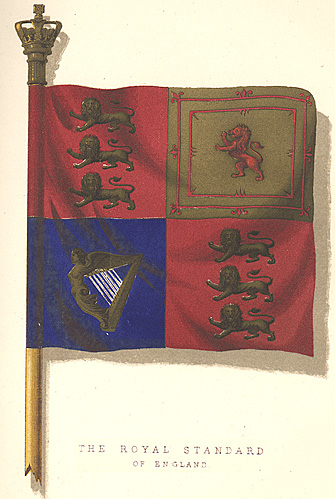 Foremost amongst the military insignia of the British nation must rank the Royal banner of England: "the ensign-in-chief of the entire army." How many ages have passed away since it was borne by the first Edward in its simple purity! how many vicissitudes has it passed through since then! how often has it bent, yet never broke! and how firmly it now holds its proud pre-eminence!
Foremost amongst the military insignia of the British nation must rank the Royal banner of England: "the ensign-in-chief of the entire army." How many ages have passed away since it was borne by the first Edward in its simple purity! how many vicissitudes has it passed through since then! how often has it bent, yet never broke! and how firmly it now holds its proud pre-eminence!
The Royal banner of England at all times bore the arms of the sovereign. In the reign of the first Edward its form was St. George alone. William the Conqueror, William the Second, and Henry the First, bore two lions "passant gardant." Three lions passant gardant were borne by Henry the Second, and until the reign of Edward the Third, who assumed the arms of France, and bore them in the first and third quarters, semi-fleur-de-lis and the arms, of England in the second and fourth quarters; and they so continued to be borne until the time of Henry the Fifth, who assumed the three fleur-de-lis, in imitation of Charles the Sixth of France, and thus the arms remained until the death of Queen Elizabeth.
When James the First ascended the throne, the arms of Scotland and Ireland were incorporated into the Royal banner of Great Britain, the arms of France and England being borne in the first and fourth quarters, those of Scotland in the second, and Ireland in the fourth. No further change of importance took place until the reigns of the three Georges, each of whom bore in the first quarter the arms of England and Scotland impaled, second quarter those of France, third Ireland, and the fourth quarter Brunswick, Lunenberg, and Hanover charged on the escutcheon with Charlemagne's crown. It so remained until 1801, when the arms of France were discontinued.
In 1801 the following order of Council was made: "That the arms were to be borne thus. First and fourth quarters England, second quarter Scotland, third Ireland, and on the escutcheon of pretence the arms of Brunswick, Lunenberg, and Hanover surmounted with the Electoral Bonnet."
In 1815, when Hanover became a kingdom, a crown was substituted for the bonnet. Upon the death of William the Fourth, the kingdom of Hanover reverted to his brother, the Duke of Cumberland, and on the accession of Her Gracious Majesty the Hanoverian escutcheon disappeared, and since then the Royal Standard has remained unaltered.
Back to Colors of the British Army: Grenadier Guards Table of Contents
Back to 19th Century: Victorian Era Book List
Back to ME-Books Master Library Desk
Back to MagWeb Master Magazine List
© Copyright 2005 by Coalition Web, Inc.
This article appears in ME-Books (MagWeb.com Military E-Books) on the Internet World Wide Web.
Articles from military history and related magazines are available at http://www.magweb.com